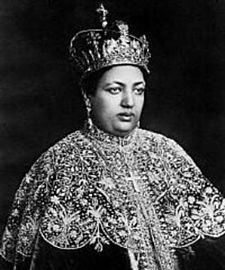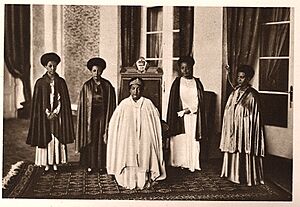Menen Asfaw facts for kids
Quick facts for kids Empress Menen Asfaw |
|||||
|---|---|---|---|---|---|
 |
|||||
| Empress consort of Ethiopia | |||||
| Tenure | 2 November 1930 – 15 February 1962 | ||||
| Coronation | 2 November 1930 | ||||
| Born | 3 April 1891 Wollo, Ethiopian Empire |
||||
| Died | 15 February 1962 (aged 70) Addis Ababa, Ethiopian Empire |
||||
| Burial | Holy Trinity Cathedral | ||||
| Spouse |
|
||||
| Issue | Princess Tenagnework Asfaw Wossen Princess Zenebework Princess Tsehai Prince Makonnen Prince Sahle Selassie |
||||
|
|||||
| House | Solomon | ||||
| Father | Asfaw, Jantirar of Ambassel | ||||
| Mother | Woizero Sehin Mikael | ||||
| Religion | Ethiopian Orthodox Tewahedo | ||||
Menen Asfaw (born Walatta Giyorgis) was the Empress of the Ethiopian Empire. She was the wife of Emperor Haile Selassie. She was born on April 3, 1891, and passed away on February 15, 1962.
Contents
Empress Menen's Early Life and Family
Menen Asfaw was born in a place called Ambassel in Ethiopia. Her father was Asfaw, a local leader known as a Jantirar. Her mother was Woizero Sehin Michael. Woizero Sehin Michael's father was Negus Mikael of Wollo, who was a king. This made Empress Menen's uncle Emperor Iyasu V.
Menen Asfaw had been married before she met Emperor Haile Selassie. It was common for people to marry young back then. She had children from these earlier marriages. Later, she met Dejazmach Tafari Makonnen, who would become Emperor Haile Selassie. They were married, and their marriage was very important for Ethiopia.
Empress Menen's Role as Empress

When Tafari Makonnen became Emperor Haile Selassie I, Menen Asfaw was crowned Empress beside him. The Emperor wrote in his autobiography that she was a kind person "without any malice whatsoever."
Empress Menen worked hard to help women in Ethiopia. She was a leader for the Ethiopian Red Cross and the Ethiopian Women's Charitable Organization. She also supported the Jerusalem Society, which helped people visit the Holy Land.
One of her biggest achievements was founding the Empress Menen School for Girls in Addis Ababa. This was the first school just for girls that offered both boarding and day classes. Girls from all over Ethiopia came to get a modern education. The Empress often visited the school and attended graduation ceremonies.
She was also very religious and supported the Ethiopian Orthodox Tewahedo Church. She helped build and improve many churches in Ethiopia and the Holy Land. She gave money for the new Cathedral of St. Mary of Zion in Axum, but she passed away before it was finished.
Empress Menen During Exile
During the Italian occupation of Ethiopia from 1936 to 1941, Empress Menen and her family had to leave the country. While in exile, she made a promise to the Virgin Mary at the Church of the Nativity in Bethlehem. She promised to give her crown to the church if Ethiopia became free again.
After Emperor Haile Selassie and his family returned to Ethiopia in 1941, a copy of the crown was made for future Empresses. The original crown that Empress Menen wore in 1930 was sent to the Church of the Nativity in Bethlehem. Empress Menen never wore a full crown again, though she sometimes wore a tiara.
Empress Menen's Influence
Empress Menen was a perfect Empress. She showed religious devotion, cared about social issues, and supported new projects. She was always majestic in her Imperial role. Publicly, she was a supportive wife, visiting schools, churches, and events with or without her husband. She did not speak publicly about political issues.
However, behind the scenes, she was the Emperor's most trusted advisor. She quietly offered advice on many topics. She chose not to be as openly political as Empress Taytu Betul, who was an earlier Empress.
Later Life and Legacy
In 1960, there was an attempt to overthrow the Emperor. Empress Menen and some of her family were briefly held at their home. The Empress was very sad about the suspicion that fell on her son, the Crown Prince, after this event.
Empress Menen passed away in 1962. She was buried in the crypt of Holy Trinity Cathedral in Addis Ababa. The Prime Minister praised her kindness, her faith, and her role as an advisor to the Emperor. The Emperor himself said that in their five decades of marriage, they never needed anyone else to solve their disagreements, and their marriage was peaceful.
Later, the Emperor built special tombs in the main part of Holy Trinity Cathedral. He wanted to move his wife's remains there and be buried next to her. However, because of a revolution, the Emperor was not buried there after his death. In November 2000, when the Emperor's remains were finally buried in the Cathedral, Empress Menen's remains were also moved to the sarcophagus next to him, just as he had wanted.
Empress Menen is highly respected by people in the Rastafari movement. They sometimes call her "Queen Omega," which goes with one of the names they use for the Emperor, "King Alpha."
Empress Menen's Children
Empress Menen and Emperor Haile Selassie had six children together:
- Princess Tenagnework
- Crown Prince Asfaw Wossen
- Princess Tsehai
- Princess Zenebework
- Prince Makonnen
- Prince Sahle Selassie
Empress Menen was also a step-mother to the Emperor's oldest child, Princess Romanework. Princess Romanework was from an earlier relationship of the Emperor. She was imprisoned in Italy during the occupation and sadly died there. Her four sons were also imprisoned, and two of them died. The remaining two sons were brought back to Ethiopia and raised by the Emperor and Empress.
Many of Empress Menen's children and grandchildren married into noble families.
| Name of Issue | Birth | Death | Spouse | Children |
|---|---|---|---|---|
| Princess Tenagnework | 12 January 1912 | 6 April 2003 | 1st Ras Desta Damtew 2nd Ras Andargatchew Messai |
Princess Aida Desta Prince Amha Desta Princess Seble Desta Rear Admiral Prince Iskinder Desta Princess Hirut Desta Princess Sophia Desta Emebet Tsige Mariam Abebe Retta Emebet Mentewab Andargatchew (died in childhood) |
| Crown Prince Asfaw Wossen | 27 July 1914 | 17 February 1997 | 1st Princess Wolete Israel Seyoum 2nd Princess Medferiashwork Abebe |
Princess Ijigayehu Princess Maryam Senna Princess Sehin Azebe Crown Prince Zera Yacob Princess Sifrash Bizu |
| Princess Zenebework | 25 July 1917 | 25 March 1934 | Dejazmatch Haile Selassie Guglsa | |
| Princess Tsehai | 13 October 1919 | 17 August 1942 | Lt. General Abiye Abebe | |
| Prince Makonnen, Duke of Harar | 16 October 1924 | 13 May 1957 | Princess Sara Gizaw, Duchess of Harar | Prince Paul Wossen Seged Makonnen, Duke of Harar Prince Mikael Makonnen Prince Taffari Makonnen Prince Dawit Makonnen (or Makonnen Makonnen) Prince Beede Mariam Makonnen |
| Prince Sahle Selassie | 27 February 1932 | 24 April 1962 | Princess Mahisente Habte Mariam | Prince Ermias Sahle Selassie |
Honours and Awards
Empress Menen received many awards and honours both from Ethiopia and other countries.
Ethiopian Honours
 Ethiopia: Knight Grand Collar of the Order of Solomon
Ethiopia: Knight Grand Collar of the Order of Solomon Ethiopia: Knight Grand Cordon of the Order of the Seal of Solomon
Ethiopia: Knight Grand Cordon of the Order of the Seal of Solomon Ethiopia: Knight Grand Cordon with Collar of the Order of the Queen of Sheba
Ethiopia: Knight Grand Cordon with Collar of the Order of the Queen of Sheba- Imperial Coronation Medal (1930)
- Refugee Medal (1944)
- Jubilee Medal (1955)
Foreign Honours
- Member of the Royal Order of the Seraphim (Kingdom of Sweden, 19 December 1959)
See also
 In Spanish: Menen Asfaw para niños
In Spanish: Menen Asfaw para niños


